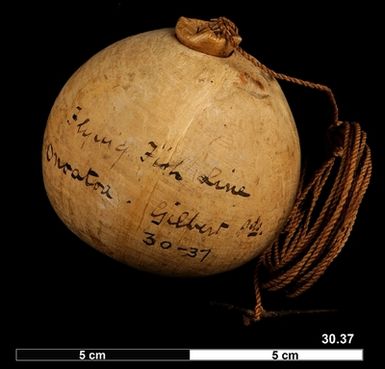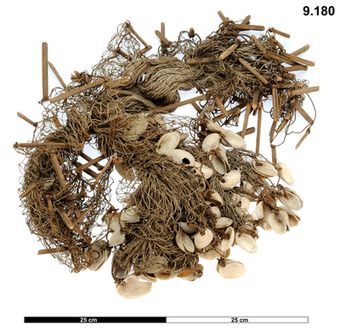Connect with Horniman Museum and Gardens
Contact this content partner to get more information about this item.
line float (float (hunting, fishing & trapping)); gorge; fish line
- Description:
- Tackle for Catching Flying Fish, Kiribati, Eastern Micronesia This gorge, a short stick of coconut wood pointed at both ends, becomes stuck between a flying fish’s jaws when it takes the bait. Traditionally, the Flying Fish (Exocoetidae spp.) was the second-most popular food fish for i-Kiribati people. The fish occur in enormous shoals in the waters of Kiribati. Catching such a prey is highly desirable, but not entirely straightforward, and i-Kiribati fishermen have developed a number of different methods to achieve this. Many methods involve night fishing using handheld flaming torches and hand-nets, but this set of tackle is for day fishing. : Mills, Andy. The gorge is strung on a strong line of plaited coconut fibre, which is suspended from a float made from the nut of the same tree. The gorge is concealed inside a piece of rock crab (a leg or claw joint, perhaps) which serves as bait. Historically, it was the responsibility of a fisherman’s children to collect crabs for him out on the reef at low tide, on the day before he went fishing for flying fish. Flying fish fishing (te tatae) was looked upon as a special activity by the i-Kiribati, and it was, like bonito fishing throughout much of Oceania, hedged about with a complex series of prohibitions before, during and after. Failure to avoid certain foods, in particular, was understood to give the fisherman a lingering smell that scared the fish away. Coconut wood, coconut fibre, coconut shell. Collected by Admiral E. H. M. Davis aboard HMS Royalist during the period 1890-1893, and purchased by the Museum in 1930. A float formed of a coconut with a coconut wood stopper. The line of coconut fibre is secured inside the float and is tied to an iron gorge that has a point at one end and a bend in the middle.
- Format:
- image
- Collections:
- Horniman Museum and Gardens
- Content partner:
- Horniman Museum and Gardens
- Availability:
- Not specified
-
Copyright status: All rights reservedFind out more about what you are able to do with this itemThis item is all rights reserved, with means you'll have to get permission from Horniman Museum and Gardens before using it. For more information, please see our use and reuse page.More informationHorniman Museum and Gardens has this to say about the rights status of this item:
http://rightsstatements.org/vocab/InC/1.0/
What can I do with this item?Non-infringing useNZ copyright law does not prevent every use of a copyright work, and this item may be hosted by an international institute or organisation. You should consider what you can and cannot do with a copyright work.No sharingYou may not copy and/or share this item with others without further permission. This includes posting it on your blog, using it in a presentation, or any other public use.No modifyingYou are not allowed to adapt or remix this item into any other works.No commercial useYou may not use this item commercially.
Related items
Welcome and warm Pasifik greetings
The information on this site has been gathered from our content partners.
The names, terms, and labels that we present on the site may contain images or voices of deceased persons and may also reflect the bias, norms, and perspective of the period of time in which they were created. We accept that these may not be appropriate today.
If you have any concerns or questions about an item, please contact us.

